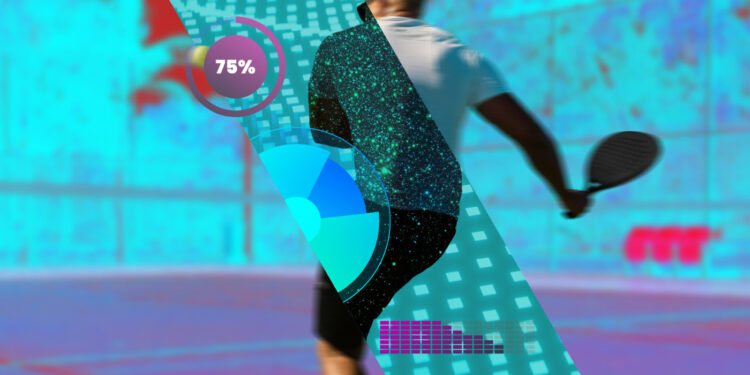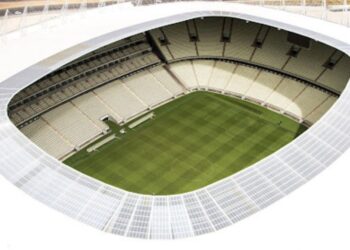“OK, sure, another smart camera…,” I thought strolling past the booth 90, just right of the main entrance and the show floor of the World Padel Summit, that has just kicked off a day earlier.
As I walked by, something caught my eye though. There was a presentation video running in the background, showing of a compact black sphere, seemingly a camera tracking every point and movement across the court.
And then it hit me – “Oh, THAT’S what it is…”
Some technologies reveal themselves in small increments. Others show up fully formed, making everything that came before feeling limited.
I’ve spent years following the evolution of sports technology, smart rackets, motion sensors, apps that promise to transform training routines. Most of these tools either focus narrowly on a single data stream or require athletes to adapt to the device’s constraints. What caught my attention here was how little friction the system introduced.
From the first demonstration, it was obvious that the camera, processing unit, and analytics software had been designed together. The technician controlling the setup tapped a tablet, and every rally appeared on a large display in real time. Shot velocity, reaction time, player movement paths, each overlay refreshed instantly. The stream felt stable and detailed in a way I’m used to seeing only in professional broadcasts.
I stood there longer than I planned, watching the data layers build a match profile that would take most clubs hours to compile by hand.
Examining the Hardware Strategy It didn’t take long to realize this wasn’t an off-the-shelf camera with a fancy case. The AIBall team explained that they had developed the optical system specifically for padel courts. The dual-lens array, they claimed, handles depth estimation and ball tracking in a way general-purpose cameras can’t replicate.
This design choice has obvious advantages. Because the hardware is standardized, the software can optimize processing without worrying about calibration errors from third-party devices. It also prevents clubs from attempting cheaper substitutions that would compromise accuracy.
But there’s a tradeoff. You can’t buy the hardware outright. Instead, you rent it, agree to keep it in their ecosystem, and rely on their support for maintenance and updates.
I’m usually cautious when vendors combine proprietary hardware with mandatory subscriptions. It creates dependencies that are hard to unwind later. Still, when I considered how many installations fail because club staff try to mix different components, I understood the reasoning. By controlling the hardware, AIBall can deliver the experience I watched on the demo court without endless configuration headaches.

The Rent-Only Model: Pragmatic or Restrictive?
I asked the team whether there were plans to release a purchase option for clubs that prefer owning equipment outright. They were clear: no such plan exists.
Their rationale is partly about quality control. Renting means they can track hardware revisions, push firmware updates, and maintain consistent performance across sites. It also means clubs can replace faulty units quickly without negotiating warranty claims.
But there’s also a business angle. Recurring revenue from rentals and analytics subscriptions ensures predictable cash flow and helps fund continued development. They are around €300 a pop per month. The strategy isn’t unusual, many sports tech companies are moving away from one-time sales. It still leaves clubs with fewer options if they ever want to switch providers.
From a purely operational perspective, I see why it appeals to facilities. They don’t have to think about hardware obsolescence or complex support agreements. For any technology that lives in a demanding environment like a padel court, that simplicity can be worth the loss of ownership.
What the System Actually Measures
AIBall doesn’t just track basic stats. In the demo, it produced a rich set of metrics that included:
- Serve speed and placement
- Shot trajectory visualizations
- Footwork efficiency scores
- Reaction time breakdowns
- Rally duration and error types
All of this appeared in real time on the tablet dashboard, and any of it could be exported or shared with players immediately. The speed and detail were striking. Even small adjustments in racket angle showed up in the visual overlays.
I spoke with a coach who’d been testing the system. He described how players responded to seeing their sessions in this format. In his experience, data presented visually had a stronger impact on engagement and learning. Rather than relying on verbal correction, he could point to specific moments where technique broke down.
That seems to be part of AIBall’s pitch: convert subjective coaching into measurable benchmarks. Whether that actually translates into improved performance over time will depend on how clubs integrate the system into training routines.
Data as a Revenue Driver
Beyond player development, there’s another dimension to AIBall: monetization.
The team claimed that facilities using the system could generate between €3,000 and €8,000 per court in additional annual revenue. This comes from offering premium analytics packages, highlight reels, and shareable video content.
I’ve heard similar promises before. What makes this model plausible is the broader shift in consumer expectations. Players increasingly expect to walk away from a session with professional-grade footage and detailed reports. When they can pay a modest fee to access that content instantly, many do.
For clubs, this revenue stream can help offset the cost of the subscription and eventually turn the system into a profit center. In a competitive market, offering advanced analysis tools can also differentiate a facility from local rivals.
Still, the success of this model depends on adoption rates. If only a small percentage of players are willing to pay for extras, the economics look different.
Performance Analysis Moves Down-market
Watching the system in action, I thought about how quickly performance analysis has migrated from elite sport to recreational play. Not long ago, this level of tracking required a production team and specialized hardware installations costing tens of thousands of euros.
Now, it can be installed in a few hours, managed by a club employee with a tablet, and operated at scale.
In the future, with proper strategy and tech roadmap, the analysis could stretch beyond your own data comparison. For example, if my girlfriend is better at padel then me (yeah, I know, I’m enough ashamed as is), you could create an AI girlfriend padel character with her stats, or even better, load the actually stats based on AIBall scanning some of her prior games. You could then get a cross-reference of all hers and yours data points, see where you’re lacking, and how to improve.
This is part of a broader trend: technologies that once only served professionals are becoming accessible to mid-tier facilities. AIBall isn’t alone in this. Tennis, soccer, and golf are all moving in the same direction.
When detailed data becomes available to average players, expectations change. Coaches have to adapt their methods. Clubs have to rethink their offerings. And athletes, regardless of skill level, become more informed consumers of performance data.
Content Is the Product
If there was one consistent message from AIBall’s team, it was that the platform isn’t just about measurement. It’s also about creating content players value.
Each session generates video clips that can be edited automatically. Highlight packages, personalized summaries, and promotional reels for social media are all integrated into the platform.
This focus makes sense. Content is what keeps users engaged and willing to pay. Analytics alone often feel abstract. Video provides a tangible record of improvement, or at least a shareable memento of participation.
I’ve seen plenty of attempts to bolt video features onto sports analytics products. Few have succeeded at making it seamless. What impressed me here was how naturally the content creation fit into the workflow. When a match ended, the software already had clips ready. There was no extra exporting or editing step.
Practical Limitations
Any time I see a polished demonstration, I try to consider what’s missing. AIBall has a few constraints that clubs will need to account for:
- Consistent lighting is important for accurate tracking.
- Some players aren’t interested in analytics or video content.
- Subscription costs will add up for facilities with many courts.
- Dependence on a single vendor creates switching risks.
These are not unusual limitations for a system that relies on proprietary hardware and software. But they’re important to keep in mind before committing.
Club Economics and Competitive Dynamics
One aspect I hadn’t considered before attending the Summit was how quickly a single installation can shift competitive dynamics in a region. If one club deploys AIBall and begins promoting professional-grade footage and detailed analytics, others may feel pressure to follow.
This creates a network effect. Players become accustomed to having data-rich sessions. Coaches start to rely on the visuals. Over time, clubs that haven’t adopted the technology risk appearing outdated.
From the vendor’s perspective, this is an effective strategy. From the buyer’s perspective, it’s a reason to move cautiously. Once you commit, extracting yourself later will be complicated.
What This Signals About the Future
Standing there watching the system compile a match summary in real time, I couldn’t help thinking that this is where all sports technology is heading.
- Controlled hardware that can’t be swapped out.
- Software subscriptions that create recurring revenue.
- Integrated content pipelines that blur the line between training tool and media platform. The result is a more polished experience for players and a more stable business model for vendors. Whether that balance benefits clubs over the long term remains to be seen.
Now I Want it, and I’m Going to Get It
I left their booth feeling that AIBall is a product built with a clear understanding of both the technical and commercial realities of modern sports.
It’s not a tool for everyone. Clubs with (initially) limited budgets or players uninterested in video will have a harder time justifying the investment. But for facilities trying to differentiate themselves and create new revenue streams on top of what they’ve already build, it offers a combination of data, content, and support that few competitors can match right now.









